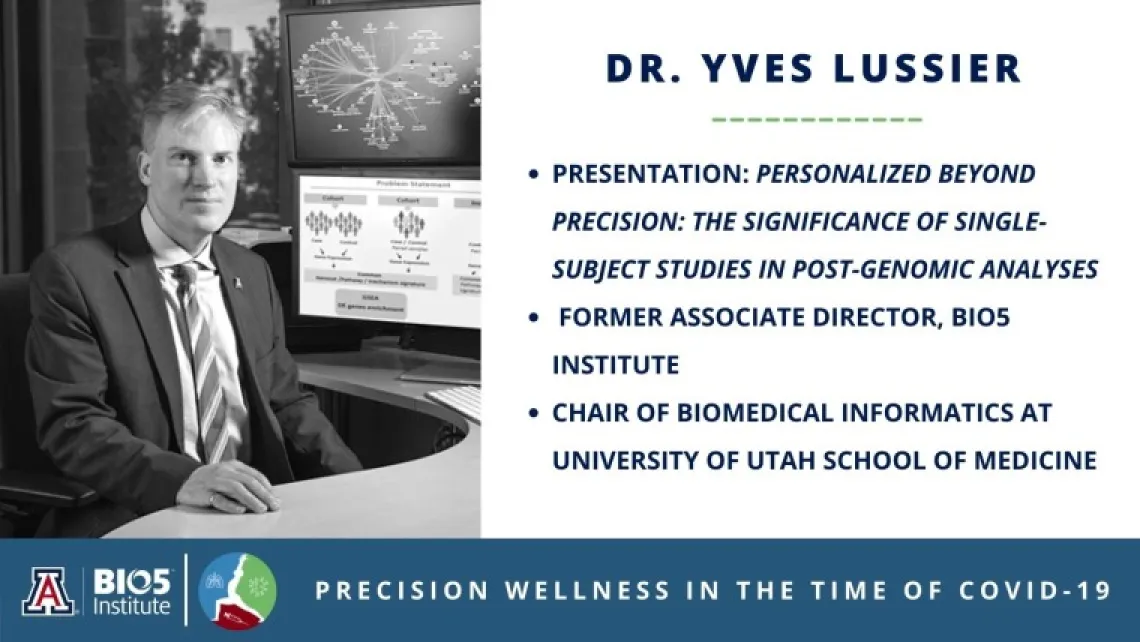From a thousand to one: Evolving precision medicine with bioinformatics
Single-subject genomic methods hold the key to understanding disease origins, assess patient vulnerability and predict treatment outcomes.

A precision medicine approach to intricate health conditions like COVID-19, cancer and cardiovascular disease requires physicians and scientists to analyze complex genetic data at the individual level. While it’s become easier to collect this information in recent years, advanced computational methods to interpret the data are lacking.
On May 17, Yves Lussier, chair of biomedical informatics at the University of Utah School of Medicine, discussed advancements in single-subject genomic studies during a Precision Wellness in the Time of COVID-19 lecture as part of The Precision Nutrition & Wellness Initiative (PNWI) at the BIO5 Institute.
Through this individualized approach, a single patient serves as both the experimental and control group. By analyzing a person’s genetic variation with disease or treatment and how those changes affect larger molecular pathways, scientists and clinicians can better predict patient outcomes and understand disease drivers.
According to Lussier, a conventional bioinformatics approach analyzes population information with the assumption that “average” disease process exists. Existing techniques assume that a single biomarker – a measurable substance whose presence is indicative of a disease – is similarly altered across all patients with the same disease.
But for most complex diseases, averages and similarities don’t exist.
These traditional approaches don’t capture individual genetic variability, making it difficult to prevent, diagnose and treat diseases in a precision medicine-style manner. To address these limitations, Lussier pioneers the field of single-subject genomic studies by focusing on what he calls the “personalome” – an individual’s unique genetic profile.
With single-subject studies, personalomes can be compared between diseased and non-diseased states within a single person. There isn’t a need to collect data on hundreds or thousands of patients, as the diseased and normal tissue from the same individual serve as the experimental case and control, respectively.
Using advanced computer programs, bioinformaticians identify which gene(s) change in a disease state in a single person and further group those altered genes into molecular pathways like cell metabolism or immune system activation. A pathway wheel is constructed for each patient, creating a snapshot of more macro-level dynamics with a certain disease.
Not only do these single-subject studies enable the detection of person-specific disease biomarkers, but individuals can be compared to one another. Based on pathway similarities and differences, researchers and clinicians can better predict which patients might be at high risk for a disease or which might respond best to certain treatments.
“When we require the pathway, not the molecule or individual gene, to be concordant between patients, we have a better strategy to understand a disease state and ultimately inform precision medicine approaches,” Lussier said.
In addition to providing a more effective way of identifying individual biomarkers, a single-subject approach may also help to reduce the cost of precision medicine, especially in developing countries.
Lussier envisions healthcare professionals in these areas learning from whole-genome profiling gathered elsewhere. By using existing banks of information, scientists and clinicians in developing areas can focus on a small number of genes involved in pathways known to be altered in certain disease states to determine if a patient is high risk for a disease or might respond to treatment in a much more quick and cheap manner.
These techniques will also decrease the time it takes to identify a gene responsible for causing a rare disease because the sheer amount of data collected from a single individual provides a “blessing of dimensionality” in which only the genes with the highest signal will be illuminated.
Lussier’s lecture is part of a five-symposia series hosted by the BIO5 Institute and The Precision Nutrition & Wellness Initiative (PNWI).
